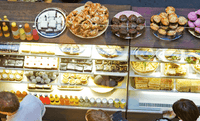- Finance
-
Equipment
- Beverage
- Coffee
-
Cooking
- Shop all cooking
- Bratt pans
- Char grills
- Chicken rotisseries
- Combi ovens
- Contact grills
- Convection ovens
- Conveyor toasters
- Cooktop oven combos
- Cooktops
- Deck ovens
- Fryers and oil filters
- Griddles
- Kebab machines
- Microwaves
- Pasta cookers
- Pizza ovens
- Range ovens
- Rice cookers
- Salamander grills
- Sous vide
- Speed ovens
- Tandoor ovens
- Toaster grills
- Waffle makers
- Wok burners
- Other
- Dishwashers
- Food display
- Food preparation
- Furniture
-
Refrigeration
- Shop all refrigeration
- Blast chillers
- Chest freezers
- Countertop fridges
- Display freezers
- Display fridges
- Gelato freezers
- Ice-cream machines
- Ice machines
- Pizza prep fridges
- Refrigerated drawers
- Sandwich prep fridges
- Slushie machines
- Under counter freezers
- Under counter fridges
- Upright freezers
- Upright fridges
- Other
- Stainless steel
- Hot deals
- Shop all equipment
- Customers
- FAQs
- Resources
- About Us
Share
Five menu makeovers to boost your profits
article
They say you can’t judge a book by its cover, but that’s exactly what customers do when it comes to assessing restaurants based on their menus.
The design, presentation and content of your menu can often be just as important as the food you’re preparing in determining what your customers order. A menu that is well designed and well thought out could be the difference between a busy restaurant humming during peak times and an over-staffed ghost town.
With this in mind, it makes sense to spend the time creating a menu that puts your best foot forward while encouraging your customers to order up and keep coming back for more. These are our tips for creating or refining a menu to help boost profits.
Think outside the page
Your menu should be an extension of your style and the vibe of your café or restaurant. You’ve created your space because you like how it looks, so follow this same instinct when designing the look of your menu. If your fit out is a bit quirky, by all means add a bit of ‘quirk’ to your menu too. A menu that looks like it belongs will create consistency, help draw your customers in and create a connection.
There is more to design than being easy on the eye
Restaurant menu design is about more than just visual appeal; it’s also about influencing your customers to buy dishes that make you more money. Below are three ideas to consider:
● Highlight profitable items – Draw attention to items you want to sell more of with simple highlights or even listing those items in a separate box.
● Place items with purpose – The first and last items in a category are the most likely to sell. Make sure you have your best performers in those spots.
● Omit the dollar sign – Studies have shown that removing the dollar sign from your price list can lead to higher customer spend.
Minimise to maximise
Try not to overwhelm your customers (or your staff) with excessive choices. A UK study revealed the optimal number of main course choices is ten, along with seven starter and dessert options. This number would be even smaller for a busy café due to the time people are spending at your venue and the space in which you have to work.
It may take some effort, but keep your menu short while making sure you cater to a range of tastes. A concise menu will help your customers spend less time deciding what to eat, which allows for a faster customer turnover and therefore increased revenue opportunity. With fewer options, you’ll give your staff the opportunity to refine and perfect the dishes, and you’re also more likely to reduce food wastage.
TIP: Looking for inspiration? Check out The French Cafe, Pacifica Restaurant, Eat Depot and White Bait for great examples of effective menu design
Keep it fresh
With a smaller number of menu options, you’ll have more opportunity to keep things fresh with a rotation of specials and seasonal dishes. This is important to get frequent diners coming back. Re-create old favourites and build hype around their return to the next menu. A dynamic menu gives your kitchen staff variety and allows them to be creative with the available produce. Not only will you remain at the cutting edge of foodie trends, you’ll also benefit from the lower cost of buying produce that’s in season.
Update often
Your menu should always be a work in progress. Determine your most profitable, popular items and give them extra life, while trimming the fat with dishes that don’t sell well. A dish may also be popular but not profitable, in which case you will need to consider the value of that menu item in attracting customers and look at ways to create add-on sale opportunities.
In summary, the look, feel, layout and contents of your menu are just as crucial to a successful food business as good customer service or a positive atmosphere. A winning menu is an ongoing process that requires equal attention to profit margins and the feedback from your staff and customers.
